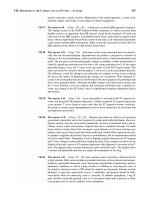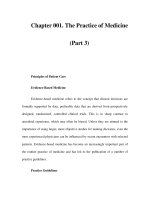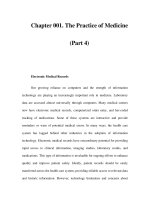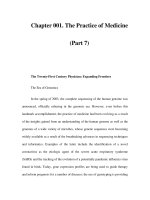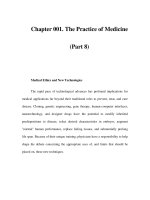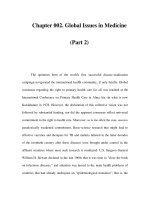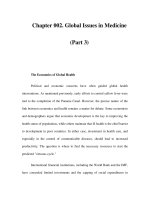Chapter 002. Global Issues in Medicine (Part 5) ppsx
Bạn đang xem bản rút gọn của tài liệu. Xem và tải ngay bản đầy đủ của tài liệu tại đây (13.53 KB, 5 trang )
Chapter 002. Global Issues in Medicine
(Part 5)
AIDS
Chapter 182 provides an overview of the AIDS epidemic in the world
today. Here we will limit ourselves to a discussion of AIDS in the developing
world.
Lessons learned in tackling AIDS in resource-constrained settings are
highly relevant to discussions of other chronic diseases, including
noncommunicable diseases, for which effective therapies have been developed.
We highlight several of these lessons below.
In the United States, the availability of highly active antiretroviral therapy
(ART) for AIDS has transformed this disease from an inescapably fatal
destruction of cell-mediated immunity into a manageable chronic illness.
In developing countries, treatment has been offered more broadly only
since 2003, and only in the summer of 2006 did the number of patients receiving
treatment exceed 25% of the number who currently need it.
(It remains to be seen how many of these fortunate few are receiving ART
regularly and with the requisite social support.) Before 2003, many arguments
were raised to justify not moving forward rapidly with ART programs for people
living with HIV/AIDS in resource-limited settings.
The standard litany included the price of therapy compared to the poverty
of the patient, the complexity of the intervention, the lack of infrastructure for
laboratory monitoring, and the lack of trained health care providers.
Narrow cost-effectiveness arguments that created false dichotomies—
prevention or treatment, rather than both—too often went unchallenged. The
greatest obstacle at the time was the ambivalence, if not outright silence, of
political leaders and experts in public health.
The cumulative effect of these factors was to condemn to death tens of
millions of poor people in developing countries who had become ill as a result of
HIV infection.
The inequity between rich and poor countries in access to HIV treatment
has rightly given rise to widespread moral indignation. In several middle-income
countries, including Brazil, visionary programs have bridged the access gap.
Other innovative projects pioneered by international nongovernmental
organizations (NGOs) in diverse settings have clearly established that a very
simple approach to ART, based on intensive community engagement and support,
can achieve remarkable results.
In 2000, the United Nations Accelerating Access Initiative finally brought
the research-based and generic pharmaceutical industries into play, and AIDS drug
prices have since fallen significantly. At the same time, easier-to-administer fixed-
dose combination drugs have become more widely available.
Building on these lessons, the WHO advocated a public health approach to
the treatment of people with AIDS in resource-limited settings. This approach,
which was derived from models of care pioneered by the NGO Partners In Health
and other groups, proposed standard first-line treatment regimens based on a
simple five-drug formulary, with a more complex (and, up to now, more
expensive) set of second-line options in reserve.
Common clinical protocols were standardized, and intensive training
packages for health and community workers were developed and implemented in
many countries. These efforts were supported by unprecedented funding through
the World Bank, the Global Fund, and PEPFAR. In 2003, the lack of access to
ART was declared a global public-health emergency by the WHO and UNAIDS,
and the two agencies launched the "3 by 5 initiative," setting an ambitious target:
having 3 million people in developing countries on treatment by the end of 2005.
Many countries have since set corresponding national targets and have
worked to integrate ART into their national AIDS programs and health systems
and to harness the synergies between HIV/AIDS treatment and prevention
activities. The G8 (Gleneagles) 2005 communiqué endorsing universal access to
HIV treatment by 2010 was another major step forward.
It is clear by now that the claims made for the efficacy of ART are well
founded: in the United States, such therapy has prolonged life by an estimated 13
years per patient on average—a success rate that would compare favorably with
that of almost any treatment for cancer or for complications of coronary artery
disease.
Further lessons with implications for policy and action have come from
efforts that are now under way in the developing world. During the past decade,
through experiences in >50 countries thus far, the world has seen that ambitious
policy goals, adequate funding, and knowledge about implementation can
dramatically transform the prospects of people living with HIV infection in
developing nations.
